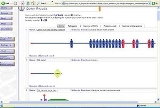
HPRD
Encyclopedia
The Human Protein Reference Database(HPRD) is a protein database accessible through the internet.
The HPRD is a result of an international collaborative effort between the Institute of Bioinformatics in Bangalore, India and the Pandey lab at Johns Hopkins University
in Baltimore, USA. HPRD contains manually curated scientific information pertaining to the biology of most human proteins. Information regarding proteins involved in human diseases is annotated and linked to Online Mendelian Inhertance in Man (OMIM) database. The National Center for Biotechnology Information provides link to HPRD through its human protein databases (e.g. Entrez Gene, RefSeq protein) pertaining to genes and proteins.
This resource depicts information on human protein functions including protein–protein interactions, post-translational modifications, enzyme-substrate relationships and disease associations. Protein annotation information that is catalogued was derived through manual curation using published literature by expert biologists and through bioinformatics analyses of the protein sequence. The protein–protein interaction and subcellular localization data from HPRD have been used to develop a human protein interaction network.
Highlights of HPRD as follows:
• From 10,000 protein–protein interactions (PPIs) annotated for 3,000 proteins in 2003, HPRD has grown to over 36,500 unique PPIs annotated for 25,000 proteins including 6,360 isoforms by the end of 2007.
• More than 50% of molecules annotated in HPRD have at least one PPI and 10% have more than 10 PPIs.
• Experiments for PPIs are broadly grouped into three categories namely in vitro, in vivo and yeast two hybrid (Y2H). Sixty percent of PPIs annotated in HPRD are supported by a single experiment whereas 26% of them are found to have two of the three experimental methods annotated.
• HPRD contains 18,000 manually curated PTMs data belonging to 26 different types. Phosphorylation
is the leading type of modification of protein contributing to 63% of PTM data annotated in HPRD. Glycosylation
, proteolytic cleavage and disulfide bridge events are the next leading contributors of PTM data.
• HPRD data is available for download in tab delimited and XML
file formats.
HPRD also integrates data from Human Proteinpedia
, a community portal for integrating human protein data. The data from HPRD can be freely accessed and used by academic users while commercial entities are required to obtain a license for use. Human Proteinpedia content is freely available for anyone to download and use.
The HPRD is a result of an international collaborative effort between the Institute of Bioinformatics in Bangalore, India and the Pandey lab at Johns Hopkins University
Johns Hopkins University
The Johns Hopkins University, commonly referred to as Johns Hopkins, JHU, or simply Hopkins, is a private research university based in Baltimore, Maryland, United States...
in Baltimore, USA. HPRD contains manually curated scientific information pertaining to the biology of most human proteins. Information regarding proteins involved in human diseases is annotated and linked to Online Mendelian Inhertance in Man (OMIM) database. The National Center for Biotechnology Information provides link to HPRD through its human protein databases (e.g. Entrez Gene, RefSeq protein) pertaining to genes and proteins.
This resource depicts information on human protein functions including protein–protein interactions, post-translational modifications, enzyme-substrate relationships and disease associations. Protein annotation information that is catalogued was derived through manual curation using published literature by expert biologists and through bioinformatics analyses of the protein sequence. The protein–protein interaction and subcellular localization data from HPRD have been used to develop a human protein interaction network.
Highlights of HPRD as follows:
• From 10,000 protein–protein interactions (PPIs) annotated for 3,000 proteins in 2003, HPRD has grown to over 36,500 unique PPIs annotated for 25,000 proteins including 6,360 isoforms by the end of 2007.
• More than 50% of molecules annotated in HPRD have at least one PPI and 10% have more than 10 PPIs.
• Experiments for PPIs are broadly grouped into three categories namely in vitro, in vivo and yeast two hybrid (Y2H). Sixty percent of PPIs annotated in HPRD are supported by a single experiment whereas 26% of them are found to have two of the three experimental methods annotated.
• HPRD contains 18,000 manually curated PTMs data belonging to 26 different types. Phosphorylation
Phosphorylation
Phosphorylation is the addition of a phosphate group to a protein or other organic molecule. Phosphorylation activates or deactivates many protein enzymes....
is the leading type of modification of protein contributing to 63% of PTM data annotated in HPRD. Glycosylation
Glycosylation
Glycosylation is the reaction in which a carbohydrate, i.e. a glycosyl donor, is attached to a hydroxyl or other functional group of another molecule . In biology glycosylation refers to the enzymatic process that attaches glycans to proteins, lipids, or other organic molecules...
, proteolytic cleavage and disulfide bridge events are the next leading contributors of PTM data.
• HPRD data is available for download in tab delimited and XML
XML
Extensible Markup Language is a set of rules for encoding documents in machine-readable form. It is defined in the XML 1.0 Specification produced by the W3C, and several other related specifications, all gratis open standards....
file formats.
HPRD also integrates data from Human Proteinpedia
Human Proteinpedia
Human Proteinpedia is a portal for sharing and integration of human proteomic data,. It allows research laboratories to contribute and maintain protein annotations. Human Protein Reference Database, integrates data, that is deposited in Human Proteinpedia along with the existing literature curated...
, a community portal for integrating human protein data. The data from HPRD can be freely accessed and used by academic users while commercial entities are required to obtain a license for use. Human Proteinpedia content is freely available for anyone to download and use.

